Colorado Blue Spruce 6"-12" Sapling |
|
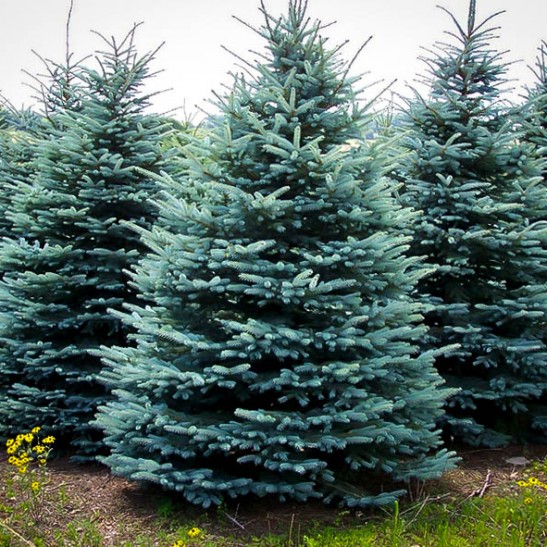
$ 7.00 USDOne of our most popular ornamental conifers, the Colorado blue spruce Picea Pungens (or simply, blue spruce) is a truly magnificent sight. Perhaps Donald Culrose Peattie described it best in A Natural History of Western Trees. "This insistently pretty tree displays its charms of tier on tier of branches graduated in perfect symmetry from the longest boughs that sweep the ground to the slender but strong top."
Its silvery blue-green coloring and perfect Christmas tree shape make this tree a great landscaping focal point on commercial and residential properties. It is also widely used for privacy or a windbreak. In the wild, Picea pungens grows to about 23 m (75 ft), but when planted in parks and gardens it seldom exceeds 15 m (49 ft) tall by 5 m (16 ft) wide. It is a columnar or conical evergreen conifer with densely growing horizontal branches. It has scaly grey bark on the trunk with yellowish-brown branches. Waxy grey-green leaves, up to 3 cm (1 in) long, are arranged radially on the shoots which curve upwards. The pale brown cones are up to 10 cm (4 in) long. 6-12 inch saplings will be shipped within 7-14 days provided the ground isn't frozen. Hardiness Zone - The colorado blue spruce can be expected to grow in Hardiness Zones 2–7. Tree Type - This is an evergreen tree, keeping its foliage year-round. Maturity Size - The Colorado blue spruce grows to a height of 50–75' and a spread of 10–20' at maturity. Growth Rate - This tree grows at a slow to medium rate, with height increases of anywhere from less than 12" to 24" per year. Sun Preference - Full sun is the ideal condition for this tree, meaning it should get at least six hours of direct, unfiltered sunlight each day. Soil Preference - The Colorado blue spruce adapts well to many soils—growing in acidic, loamy, moist, rich, sandy, well-drained and clay soils. It requires normal moisture with moderate tolerance to flooding and drought. Attributes - This tree:
Wildlife Value - This spruce provides food and shelter for siskins, nuthatches and crossbills. History/Lore - The Colorado blue spruce is such a delight that nature seems to have kept it a well-guarded secret for a very long time. It was not until 1862 that this spectacular species was discovered growing in enchanted meadows and stream sides high up in the Rocky Mountains. Once found, the fame of this blue spruce spread quickly, and today it is one of our most widely planted landscape trees as well as the state tree of Colorado. When writing Handbook on Conifers in 1969, Henry Tuescher, curator emeritus of the Montreal Botanical Garden, called the Colorado blue spruce one of the five finest conifers. Tuescher gave no reasons for this honor except for the tree's exceptional beauty. Moisture - Requires normal moisture with moderate tolerance to flooding and drought. Leaves - The needles are stiff, prickly and about 1 to 1-1/2 inches in length. They surround the branch at nearly right angles and are usually silvery to blue-green, but occasionally the blue is absent. Flower Color - Green; orange; purple; nondescript. Bloom Time - April-May Fruit Description - Light brown, 3 to 4 inch cones which hang downward on the branches and are concentrated in the upper crown.
|
|
Bur Oak 6"-12" Sapling |
|
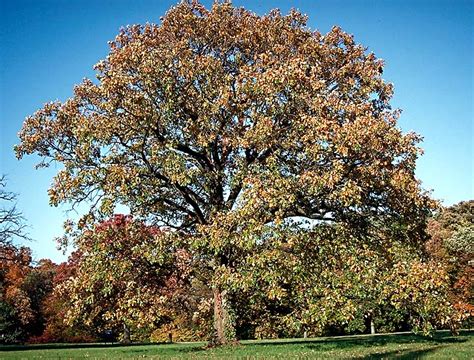
$ 7.00 USDThe bur oak Quercus macrocarpa is a mighty sight to behold. A coarsely textured crown, wild and wooly acorns and a massive trunk with rough and deeply furrowed bark combine to make one impressive tree. But really, those characteristics helped this oak survive the elements of its wide-reaching natural range. In fact, the natural bur oak range is the northern- and western- most of all the eastern oak species. While its massive size counts this tree out for most urban and suburban yards, the bur oak make a great choice for parks, institutional grounds and expansive yards. Hardiness Zone - Zones 3-8 Tree Type - The Bur Oak falls into the following type(s): Shade Maturity Height - The Bur Oak grows to be 70' to 80' feet in height. The Bur Oak has a spread of about undetermined at full maturity. Growth Rate - This tree grows at a Slow growth rate. Sun Preference - The Bur Oak does well in Full exposure(s). Soil Preference - The Bur Oak grows in Acidic, Alkaline, Clay, Drought Tolerant, Loamy, Sandy, Well Drained, Wet, Wide Range soils. Shape - The Bur Oak has a(n) Rounded shape. Attributes - In addition to its notable strength, Bur Oak has other attributes that make it a splendid tree for urban landscapes. It provides food for squirrels, dense shade, and is resistant to air pollution and heat stress. Its generally slow growth is compensated by longevity that may exceed 200 to 300 years. Wildlife Value - Bur oak acorns are at the top of the food preference list for wood ducks, wild turkeys, whitetail deer, rabbits, mice, squirrels and other rodents. History/Lore - Bur Oaks are the dominant trees that grace Arbor Day Farm and the hills and valleys surrounding Nebraska City. There, on the banks of the lower Missouri River, this magnificent Oak is close to the heart of its natural range. It is the most western of the eastern Oaks, extending all the way to the foothills of the Rockies where it is reduced to a shrub. In pioneer days on the plains, it came to the rescue of unfortunate travelers who needed new wagon tongues, wheel hubs or spokes. Sioux City, Iowa is the location of the Council Oak, so named because Lewis and Clark held council with the Native Americans under its already 150 year old branches. Moisture - Moderate moisture with some drought tolerance. Leave - This tree alternates, large, 6 to 12 inch wide leaves. Each leaf has 5 to 9 lobes separated about half way by a pair of particularly deep sinuses. Flower Color - Drab brown color, not significant. Blooms - April May The acorns of the Bur Oak are larger than most other Oaks and have a cap that extends about half way down and is conspicuously fringed. This feature gives the tree its other name, the Mossycup Oak. |
|
Northern Red Oak 6"-12" Sapling |
|
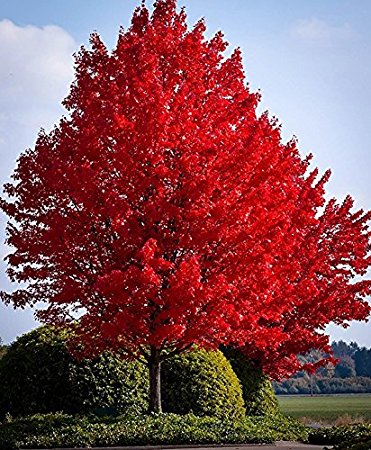
$ 7.00 USDThe northern red oak Quercus Rubra has been called “one of the handsomest, cleanest, and stateliest trees in North America” by naturalist Joseph S. Illick, and it is widely considered a national treasure. It is especially valued for its adaptability and usefulness, including its hardiness in urban settings. This medium to large tree is also known for its brilliant fall color, great value to wildlife and status as the state tree of New Jersey. Whether you’re selecting a tree to plant in your front yard or out on the farm, it’s a fast-growing species worth keeping in mind. Hardiness Zone - The Northern Red Oak can be expected to grow in the zones listed Tree type - The Northern Red Oak falls into the following type(s): Shade Maturity Size - The Northern Red Oak grows to be 60' to 75' feet in height. The Northern Red Oak has a spread of about 45' at full maturity. Shape - The Northern Red Oak has a(n) Rounded shape. Growth Rate - This tree grows at a Fast growth rate. Sun Preference - The Northern Red Oak does well in Full exposure(s). Soil Preference - The Northern Red Oak grows in Acidic, Clay, Drought Tolerant, Loamy, Moist, Sandy, Well Drained soils. Attributes - The Red Oak is an American treasure, and one easy to own. One of its many special features is that it is easier than most trees to transplant and it can tolerate the conditions of cities and towns amazingly well. In parks, along streets and in home landscapes, the tree provides cool shade from its dense crown, brilliant fall colors and a high degree of safety thanks to the superior strength of its wood. Wildlife Value - Red oak acorns are at the top of the food preference list for blue jays, wild turkeys, squirrels, small rodents, whitetail deer, raccoons, and black bears. Deer also browse the buds and twigs in wintertime. History/Lore - The Red Oak has been a favorite of both lumbermen and landscapers since colonial times. The tree has also found favor when transplanted in Europe. It is believed that Bishop Compton's garden, near Fulham in England, received the first Red Oak transplant abroad in the late 17th century. In 1924, there were over 450 acres of Red Oak plantations in Baden, Germany. Moisture - Normal moisture with some drought tolerance. Leaves - The leaves alternate, simple, 4 to 8 inches long with pointed, spine-tipped lobes. Dark green color turning russet-red to bright red in autumn. Bloom Time - April-May Flower Color - Pale, yellow-green catkins appear at about the same time new foliage is expanding. Fruit Description - The Acorn is round, 3/4 to 1 inch long, flat, thick, saucer like cap, brown. |
|
Norway Spruce 6"-12" Sapling |
|
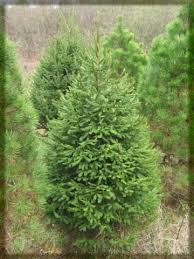
$ 7.00 USDNorway spruce Picea Abies is a familiar sight in much of the United States, but it’s really a tree of Europe. Throughout the globe, this tree has many uses including lumber, pulpwood, Christmas trees and landscape specimen trees. Its dense branching pattern and tolerance of soil variations has also made it a popular tree for windbreaks. If you have enough space and want to add a sense of formal dignity to your landscape, the Norway spruce will suit you well. Red pine is a coniferous evergreen tree characterized by tall, straight growth in a variety of habitats. It usually ranges from 20–35 m (66–115 ft) in height and 1 m (3 ft 3 in) in trunk diameter, exceptionally reaching 43.77 m (143 ft 7 in) tall. The crown is conical, becoming a narrow rounded dome with age. The bark is thick and gray-brown at the base of the tree, but thin, flaky and bright orange-red in the upper crown; the tree's name derives from this distinctive character. Some red color may be seen in the fissures of the bark. The species is self pruning; there tend not to be dead branches on the trees, and older trees may have very long lengths of branchless trunk below the canopy. The leaves are needle-like, dark yellow-green, in fascicles of two, 12–18 cm (4 3⁄4–7 in) long, and brittle. The leaves snap cleanly when bent; this character, stated as diagnostic for red pine in some texts, is however shared by several other pine species. The cones are symmetrical ovoid, 4–6 cm (1 1⁄2–2 1⁄4 in) long by 2.5 cm (1 in) broad, and purple before maturity, ripening to nut-blue and opening to 4–5 cm (1 1⁄2–2 in) broad, the scales without a prickle and almost stalkless. Red pine is notable for its very constant morphology and low genetic variation throughout its range, suggesting it has been through a near extinction in its recent evolutionary history. A genetic study of nuclear microsatellite polymorphisms among populations distributed throughout its natural range found that red pine populations from Newfoundland are genetically distinct from most mainland populations, consistent with dispersal from different glacial refugia in this highly self-pollinating species Hardiness Zone - The norway spruce can be expected to grow in Hardiness Zones 3–7. Mature Size - The Norway spruce grows to a height of 40–60' and a spread of 25–30' at maturity. Growth Rate - This tree grows at a medium to fast rate, with height increases of anywhere from 13" to more than 24" per year. Sun Preference - Full sun is the ideal condition for this tree, meaning it should get at least six hours of direct, unfiltered sunlight each day. Soil Preference - The Norway spruce grows in acidic, loamy, moist, sandy, well-drained and clay soils. It has some drought tolerance. Attributes - This tree:
Wildlife Value - Norway spruce trees support a wide variety of wildlife. They are important as winter cover for deer and small game including grouse, hare and woodcock. Song birds and fur bearers also frequent these forest types. Norway spruce also makes a good roosting tree for hawks and owls. History/Lore - The Norway spruce hails from Europe. And while this species does grow in Norway, the name is a bit of a misnomer. This tree grew in Eurasia, the Black Forest and other parts of the continent long before making its way to Norway around 500 B.C. As people emigrated, they often brought trees with them from the Old Country to plant as ornamentals on new homesteads. |
|
Red Maple 6"-12 Sapling |
|
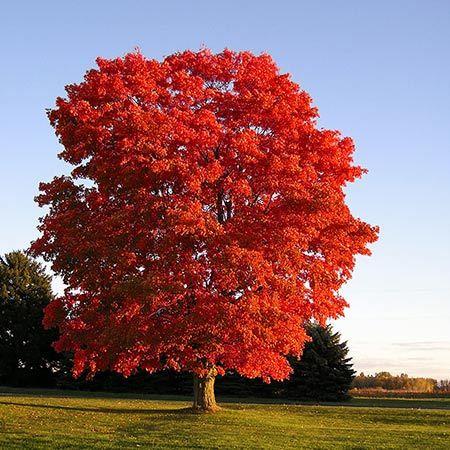
$ 7.00 USDRed maple Acer Ruberum is one of the best named of all trees, featuring something red in each of the seasons—buds in winter, flowers in spring, leafstalks in summer, and brilliant foliage in autumn. This pageant of color, along with the red maple's relatively fast growth and tolerance to a wide range of soils, makes it a widely planted favorite. The natural range of red maple begins roughly at the eastern edge of the Great Plains north to Lake Superior, extending eastward to the Atlantic. But homeowners and urban foresters are growing this tree all across the United States. Zones 3-9 The Red Maple falls into the following type(s): Ornamental with an oval shape. The Red Maple grows to be 40' to 60' feet in height and has a spread of about 40' at full maturity. This tree grows at a Medium to Fast growth rate. The Red Maple does well in Full, Partial Shade exposure(s). The Red Maple grows in Acidic, Clay, Loamy, Moist, Rich, Sandy, Silty Loam, Well Drained, Wet soils. The Red Maple is one of the best named of all trees. There is something red in all seasons - buds in winter, flowers in spring, leafstalks in summer and brilliant foliage in autumn. This pageant of color, along with the tree's relatively fast growth and tolerance to a wide range of soils, makes it a widely planted favorite. The fruits (samaras) provide food for many kinds of rodents, such as squirrels. Rabbits and deer eat the tender shoots and leaves of red maples. The Red Maple has a lot of claims to fame, including the greatest north-south range of any tree species living entirely in the eastern forests. (Newfoundland to southern Florida). It is also the state tree of Rhode Island. No one seems to know the whole story of why it was selected by the citizens of this smallest of states. In the 1890's a Rhode Island school commissioner gave students a list of trees and asked them to vote on their favorite. Red Maple won, but it was not until 1964 that it was officially adopted as the state tree - making Rhode Island one of last states in the nation to proclaim its tree. The selection may have been because Rhode Island is from the Dutch, meaning "red island." Since the state bird is the Rhode Island red hen, it makes sense that the tree would be one noted for red. The nation's largest Red Maple lies far to the south of Rhode Island in Great Smokey Mountains National Park. This tree was declared champion in 1997 by American Forests and is listed in the National Register of Big Trees as being 141 feet tall and just over 7 feet in diameter at 4-1/2 feet above ground. Prefers wet soil conditions. Slight drought tolerance. Opposite, 2-6 inches in length and width, 3-5 triangular lobes with v-shaped sinuses, single or double toothed margins. Emerging color is red tinged gradually changing to medium to dark green above, silvery gray with hairy veins beneath. Autumn color is yellow to red. The petiole (leafstem) is often red. The dense red or sometimes yellow clusters of small flowers are a dependable harbinger of spring. Winter to spring Blooms. This tree produces twin seeds bound at their tips to a long, drooping stem. Attached to the seeds are wings up to 1 inch long and 1/4 inch wide. The seeds ripen in late spring instead of fall like other maple trees. |
|
Eastern Redbud 6"-12" Sapling |
|
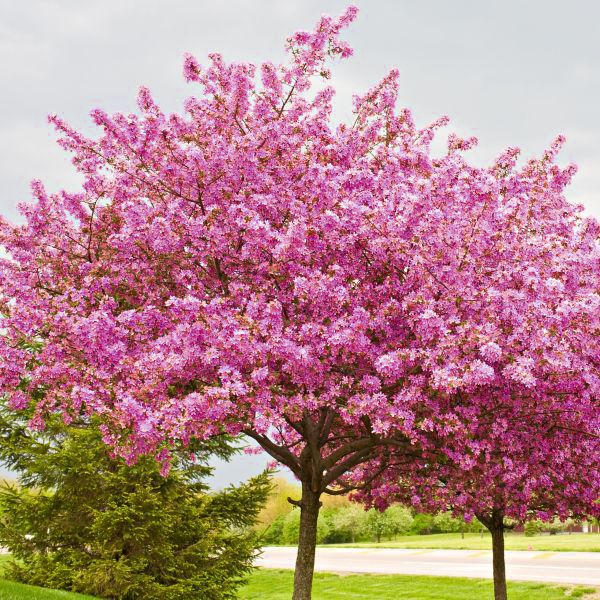
$ 7.00 USDKnown as the harbinger of spring, the eastern redbud’s Cercis Canadensis delicate blossoms and buds are one of the season’s most dramatic displays. But this tree’s beauty doesn’t end with its flowery show. Unique and irregular branching patterns combine with a trunk that commonly divides close to the ground to create a very handsome, spreading and often flat-topped crown. Even in winter, covered with snow, the eastern redbud is stunning. This species will add a lot of elegance to any space. Zones 4-9 The Eastern Redbud falls into the following type(s): Ornamental with a round shape. The Eastern Redbud grows to be 20' to 30' feet in height and has a spread of about 25' to 35' at full maturity. With a Medium Growth Rate. The Eastern Redbud does well in Full, Partial Shade exposure(s). The Eastern Redbud grows in Acidic, Alkaline, Clay, Loamy, Moist, Rich, Sandy, Well Drained, Wide Range soils. Spectacular spring blossoms. The seeds provide winter food for birds. An excellent tree for planting near utility lines. Provides good shade when planted near patios. Well known for its beauty, it is the state tree of Oklahoma. Northern bobwhite and a few songbirds, such as chickadees, will eat the seeds, and it can be used for nesting sites and nesting materials, it also provides shelter for birds and mammals. Native to North America and Canada with cousins in Europe and Asia. First cultivated in 1811. The Spaniards noted Redbuds and made distinctions between the New World species and their cousins in the Mediterranean region in 1571. George Washington reported in his diary on many occasions about the beauty of the tree and spent many hours in his garden transplanting seedlings obtained from the nearby forest. The leaves of this tree are reddish-purple, changing to dark green and then yellow. Rosy-pink flowers in April. This tree produces a pod, brown-brownish black and 2 to 3 inches long.
|
|
River Birch 6"-12" Sapling |
|
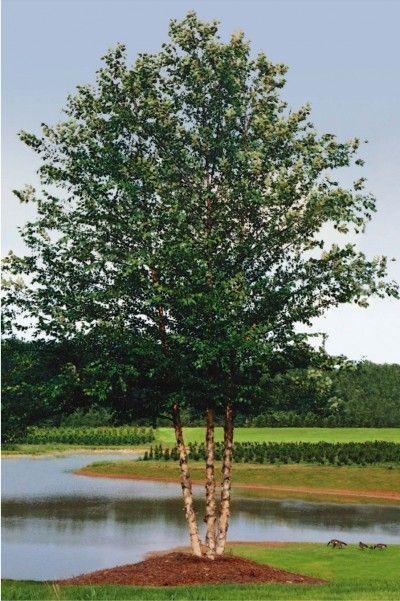
$ 7.00 USDAs its name suggests, the river birch betula nigra naturally grows along river banks. But as a landscape tree, it can be planted almost anywhere in the U.S. The species is valued for its relatively rapid growth, tolerance of wetness and some drought, unique curling bark, spreading limbs and relative resistance to birch borer. The river birch has not yet reached the popularity of many maples and oaks, but it is well on its way. In 2002, one of its cultivars was even named the Urban Tree of the Year by the Society of Municipal Arborists. Zones 4-9 The River Birch falls into the following type(s): Shade & Ornamental with an oval shape. The River Birch grows to be 40' to 70' feet in height and has a spread of about 40' to 60' at full maturity. This tree grows at a Medium to Fast growth rate. The River Birch does well in Full, Partial Shade exposure(s). The River Birch grows in Acidic, Clay, Drought Tolerant, Loamy, Moist, Sandy, Well Drained, Wet, Wide Range soils. The River Birch has become a popular landscape tree because of its distinctive bark and graceful crown. It also is said to be the Birch most resistant to borers, and can tolerate drier conditions than other Birches. Its small but plentiful seeds are appreciated by a wide range of songbirds. The catkins of the River Birch are used by redpolls and pine siskins. The foliage is eaten by deer and other browsers. The River Birch is one of the 12 Birch species that extend southward from the Arctic Circle. It is the only one that grows naturally at low elevations in the southeastern part of the United States. Mud is a natural bed for the seedlings and the tree is excellent for holding stream banks and thus helping to keep erosion in check. While it will tolerate moderate flooding, it also has some drought resistance. This trees leaves are 1-1/2 to 3 inches long and 1 to 2 inches wide with tiny hairs on stem and the underside of a stout midrib. Flowers are brown or green from April to May. The fruit is elongated, 1 to 3 inches long. |
|
Scarlet Oak 6"-12" Sapling |
|
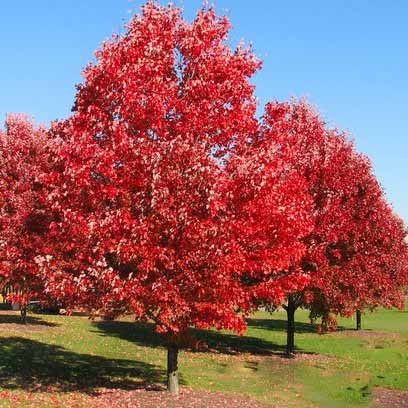
$ 7.00 USDAptly named, the scarlet oak Quercus Coccinea is a parade of red throughout the seasons. In the early spring, new leaves unfurl with a red hue. The vibrant red fall display is truly magnificent. And those red leaves often hangs on through the first snow, giving winter a touch of much-needed color. The inner bark of the scarlet oak is even red. This tree is a very popular landscape choice for more than vivid color, however. Tolerance for poor soils and wind resistance combine with its beauty to make the scarlet oak a widely used species throughout parks, in large yards and along streets. Perhaps these are also the reasons why it has the honor of being the official tree of District of Columbia. Zones 4-9 The Scarlet Oak falls into the following type(s): Shade & Ornamental with a rounded shape. The Scarlet Oak grows to be 60' to 80' feet in height and has a spread of about 40' to 50' at full maturity. It has a medium growth rate. The Scarlet Oak does well in Full exposure(s). The Scarlet Oak grows in Drought Tolerant, Wide Range soils. The Scarlet Oak tree is well named. Its early spring foliage is often red, its inner bark is reddish, and in autumn the leaves are brilliant red or scarlet. The acorns of this tree are a favorite food for gray squirrels, chipmunks, mice and birds, especially blue jays. It is a common tree in the Appalachian Mountains but has become a popular landscape tree throughout the eastern and central United States. Scarlet oak acorns are an important food source for many large songbirds, wild turkeys, grouse, squirrels, and whitetail deer. The native range of the Scarlet Oak tree extends from Maine to Florida and west to Missouri. The first scientific observations of this tree were made in 1691. The brilliant red leaf color extends well into winter, making an excellent splash of color against a white snow background. Normal moisture preferred, but with some drought tolerance. This trees leaves are 4 to 7 inches long with 7 to 9 (rarely) narrow, bristle-tipped lobes separated by deep sinuses. Green in summer with brilliant red or scarlet color in autumn. Brown, faded flower color in April to May. Not noteworthy. The fruit is round, 1 inch long, attractive to wildlife. |
|
Silver Maple 6"-12" Sapling |
|

$ 7.00 USDPic is underside of leaves. Silver is definitely the right word to describe this maple, Acer Saccharinum. With even a light wind, the tree produces a lovely shimmery effect thanks to the silvery undersides of its leaves. The bark, too, is silver in color, particularly when the tree is young. But believe it or not, the lovely silvery nature of this tree is not its biggest draw. Fast growth has become the name of the game in the world of landscaping, and the silver maple is a champ in this department. If you have the space to accommodate its large size and wide-spreading root system, you’ll be rewarded with quick shade. Zones 3-9 The Silver Maple falls into the following type(s): Shade with a Vase shape. The Silver Maple grows to be 50' to 80' feet in height and has a spread of about 35' to 50' at full maturity. It has a fast growth rate. The Silver Maple does well in Full, Partial Shade exposure(s). The Silver Maple grows in Acidic, Drought Tolerant, Moist, Wide Range soils. The Silver Maple takes it's name from the silvery-white undersides of the leaves that tend to shimmer and dance in the slightest breeze. Other attributes that make it a popular tree are it's tolerance to urban conditions such as poor and compacted soil, hot, dry conditions, and air pollution. It is also popular due to it's rapid growth. The buds of the Silver Maple are eaten by squirrels in early spring. It also provides nesting sites for ducks and other birds. Beavers find the trees delicious. Early settlers in the Ohio Valley found the sap from the Silver Maple to be superior to other Maple trees for sugar quality but production was too slow for commercial purposes. The tree has always been a delight to forest-watchers as the slightest breeze will turn the tree into a shimmering silver-green color display and the bark has a silver look to it in the winter that contrasts nicely with snow. Wide range of moisture conditions. Can withstand some flooding and has moderate drought tolerance. Leaves are opposite on twigs, 3 to 6 inches in both length and width, with 5 lobes separated by notably deep, narrow sinuses. Green on top and silver-green on the bottom. The bloom is yellow-red from early to mid-March. The fruit is elongated, 1-2 inches long, green to brown in color.
|
|
Sugar Maple 6"-12" Sapling |
|
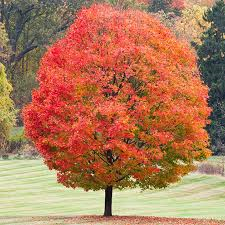
$ 7.00 USDThe sugar maple acer saccharum is one of America’s best-loved trees. In fact, more states have claimed it as their state tree than any other single species—for New York, West Virginia, Wisconsin and Vermont, the Maple Tree stands alone. While commercially planted for its delicious syrup and value as lumber, this maple tree makes a great addition to any yard or park. And one of its most prominent features is amazing fall color. As the seasons change, the leaves turn vibrant shades of yellow, burnt orange and red. Zones 3-8 The Sugar Maple falls into the following type(s): Shade & Ornamental with an oval shape. The Sugar Maple grows to be 60' to 75' feet in height and has a spread of about 40' to 50' at full maturity, with a slow to medium growth rate. The Sugar Maple does well in Full, Partial Shade exposure(s). The Sugar Maple grows in Acidic, Alkaline, Drought Tolerant, Well Drained soils. The Sugar Maple tree is one of America's most loved trees. Here is a tree that lives to serve! Perhaps it is best known for its syrup, or Syrop as the French explorers called it when they found Native Americans enjoying this spring delight. Today, about two million gallons of the liquid gold support an important rural industry in the United States. Its gifts include shade and fall beauty that are unparalleled in park and home landscapes. Finally, as one last service during its sojourn on earth, Sugar Maple as firewood has few rivals - it splits easily, gives off an enormous amount of heat, produces few sparks, and ends in fine, rich ashes that pioneers turned into soap but today can enrich gardens. Sugar Maples are commonly browsed by white-tailed deer, moose, and snowshoe hare. Squirrels feed on the seeds, buds, twigs, and leaves. The wood of the Sugar Maple tree has always been highly valued for furniture because of its beauty, and for products ranging from flooring to bowling pins thanks to its extreme hardness. During the 2001 baseball season, Barry Bonds switched from the traditional Ash wood baseball bat to one made of Maple and hit 73 home runs, a new record! In 1663, chemist Robert Boyle informed the Europeans about the tree in the new world that produced a sweet substance and John Smith was among the first settlers who remarked about the Native American's sugar processing and the fact that they used the product for barter. It has been used for medicine because of its bone-building phosphates that enhance calcium retention. Prefers moist soil conditions but has moderate drought resistance. This trees leaves are 3 to 5 inches across with 5, or rarely 3, distinctive lobes. Autumn coloration is a striking red and yellow. Flowers are green to yellow from April until May. This tree produces two winged seeds on a single stem, each approximately 1-1/4 to 1-1/2 inches long. |
|
White Dogwood 6"-12" Sapling |
|
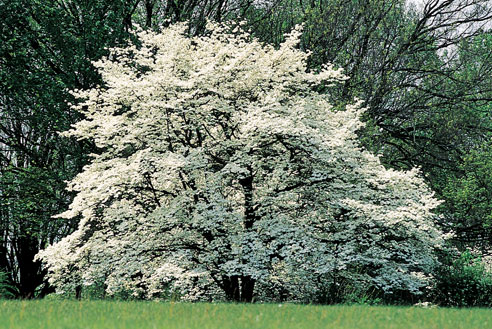
$ 7.00 USDAn excellent landscape choice for all four seasons, the White Dogwood Carnus Florida is a favorite in many yards and gardens. White “flowers” show their beauty in spring, foliage turns a vibrant red-purple in fall and glossy red fruits attract winter songbirds for the enjoyment of all. This tree is a great option to plant near utility lines, next to larger buildings or near patios. It also offers nice contrast when planted along with Pink or Red Dogwoods with larger evergreens in the background. Zones 5-9 The White Dogwood falls into the following type(s): Flowering & Ornamental with a round shape. The White Dogwood grows to be 20' to 25' feet in height and has a spread of about 25' at full maturity. It has a Medium growth rate. The White Dogwood does well in Full, Partial Shade exposure(s). The White Dogwood grows in Acidic, Clay, Loamy, Moist, Rich, Sandy, Well Drained soils. This is a good tree for planting near utility lines, next to larger buildings, or near patios. It is also an excellent contrast tree when planted along with Pink or Red Dogwoods with larger evergreen backgrounds. The fruit is well-liked by songbirds. The seed, fruit, flowers, twigs, bark and leaves are all used as food by various animals. At least 36 species of birds, including ruffed grouse, bobwhite quail and wild turkey are known to eat the fruit. Chipmunks, foxes, squirrels, skunks, rabbits, deer, beaver, black bear plus other mammals, also eat the fruit. Foliage and twigs are browsed heavily by deer and rabbits. Native from Massachusetts to Florida, West to Texas. Cultivated in 1731. A favorite in America for centuries, George Washington planted it at Mt. Vernon as did Thomas Jefferson at Monticello. Early Native Americans made medicinal teas from its bark and desperate Civil War doctors used this tea as a quinine substitute. The wood is extremely hard and has been used for Weaver's shuttles, chisel and maul handles, golf club heads and yokes. Moist, well-drained soil The leaves are opposite, oval or ovate, 3-6" long, and dark green. White flowers from April to May. This tree has glossy, red fruit eaten by birds when ripened in the fall. |
|
White Fir 6"-12" Sapling |
|
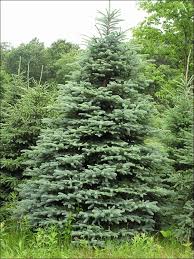
$ 7.00 USDLong ago, naturalist Donald Peattie recognized the beauty and adaptability of the white fir Abies Concolor and accurately predicted that its future “lies in its value as an ornamental.” Its shape, color and ability to thrive on harsh sites has made the tree a favorite for urban landscaping. It has also become a major component of the Christmas tree industry. Zones 4-7 The White Fir falls into the following type(s): Evergreen with a pyramidal shape. The White Fir grows to be 30' to 50' feet in height and has a spread of about 20' at full maturity. This tree grows at a Slow to Medium growth rate. The White Fir does well in Full, Partial Shade exposure(s). The White Fir grows in Acidic, Drought Tolerant, Loamy, Moist, Sandy, Well Drained soils. The White Fir, sometimes called Concolor Fir, is a favorite Christmas tree among discerning buyers. It is also an important timber tree in its natural range within the Sierra Mountains and the western slopes of the central Rockies. It is widely planted as a beautiful ornamental in the East. Not surprisingly, White Fir is named for its light-colored bark and the silvery or "glaucous" color of its needles. Grouse like to eat the buds and needles, and find white fir a good roosting tree. The seeds are eaten by squirrels, rodents, chickadees, crossbills, and Clark's nutcrackers. Deer browse on seedlings, buds and needles, and porcupines gnaw on the bark. White Fir is one of the 40 members of its genus worldwide, and nine in North America. Its common name is descriptive of the foliage, whereas its scientific name is not too helpful. "Abies" is simply the ancient Latin word for Fir trees, and "Concolor" means "together, or of one color." This wild mountain resident has no outstanding credits to its name in the lumber business. It does have commercial value and is harvested for miscellaneous products, but it is far overshadowed by its stronger woodland associates. Long ago, naturalist Donald Peattie predicted the real glory of this species. "Rather does the future of this tree lie in its value as an ornamental," he wrote in 1953. It is today a favorite for urban landscaping. Normal moisture required; drought tolerant. The needles of the White Fir are silvery blue to silver-green; flat; blunt; 2 to 3 inches long. (The longest of the Fir family.) Red from April to May; nondescript. The fruit is elongated; upright; 3 to 6 inches long; dry or hard; brown.
|
|
White Pine 6"-12" Sapling |
|
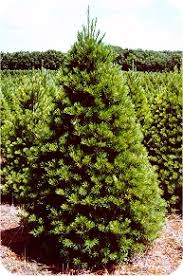
$ 7.00 USDThe eastern white pine Pinus Strobus has played a very important role throughout the history of America. In colonial days, the best of the trees were set apart by the king for masts on British ships. As the nation grew, the lumber of white pines built our homes and businesses. Today it is still a valuable commercial tree but also favored in parks and spacious yards—both for its beauty and its fast growth. It has also been named the state tree of both Maine and Michigan. Like all members of the white pine group, Pinus subgenus Strobus, the leaves ("needles") are in fascicles (bundles) of 5, or rarely 3 or 4, with a deciduous sheath. They are flexible, bluish-green, finely serrated, 5–13 cm (2–5 in) long, and persist for 18 months, i.e., from the spring of one season until autumn of the next, when they abscise. The cones are slender, 8–16 cm (3 1⁄4–6 1⁄4 in) long (rarely longer than that) and 4–5 cm (1 1⁄2–2 in) broad when open, and have scales with a rounded apex and slightly reflexed tip. The seeds are 4–5 mm (5⁄32–3⁄16 in) long, with a slender 15–20 mm (5⁄8–3⁄4 in) wing, and are dispersed by wind. Cone production peaks every 3 to 5 years. While Eastern White Pine is self-fertile, seeds produced this way tend to result in weak, stunted, and malformed seedlings. Mature trees are often 200–250 years old, and some live to over 400 years. A tree growing near Syracuse, New York was dated to 458 years old in the late 1980s and trees in Michigan and Wisconsin were dated to approximately 500 years old. Hardiness Zone - The eastern white pine can be expected to grow in Hardiness Zones 3–8. Tree Type - This is an evergreen tree, keeping its foliage year-round. Maturity Size - The eastern white pine grows to a height of 50–80' and a spread of 20–40' at maturity. Growth Rate - This tree grows at a fast rate, with height increases of more than 24" per year. Sun Preference - Full sun and partial shade are best for this tree, meaning it prefers a minimum of four hours of direct, unfiltered sunlight each day. Soil Preference - The eastern white pine grows in acidic, moist, well-drained and dry soils. While it does best in moist soil, the tree can has been known to tolerate everything from dry, rocky ridges to bogs. Attributes - This tree:
Wildlife Value - Eastern white pine seeds are favored by black bears, rabbits, red squirrels and many birds, especially red crossbills. While potentially damaging to the trees, the bark is eaten by mammals such as beavers, snowshoe hares, porcupines, rabbits and mice. White pines provide nesting sites as well for many birds including woodpeckers, common grackles, mourning doves, chickadees and nuthatches. A 6"-12" Sapling will be shipped provided the ground isn't frozen. |
|
- Home
- All About Quail
- Game Birds for Sale
- Eating Eggs
- Hatching Eggs
- Earthy Treasures
- New Teas
- Loose Leaf Teas
- Tea Infusers
- Cold Fusion Tea
- Honey
- Honey 101
- Honey Recipes
- Tree Saplings
- Replanting The Smokies
- Tree Ideas
- Tree Info
- Succulents
- Air Plants
- Tea 101
- How to Brew Perfect Tea
- Tea Benefits
- Chinese Tea History
- Tea and Spice Jars
- Favors
- Culinary Herbs
- Grillin' Spices
- Heat-n-Eat Soup
- Stone Soup
- Botanical Herbs
- Blessed Thistle
- Drying Herbs
- Rv Resorts and B 'n' B's
- About Thistle Dew
- Stores
- Programs
- Organic Certs
- Orders
- Contact Us
- Upcoming Shows
